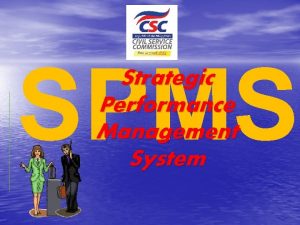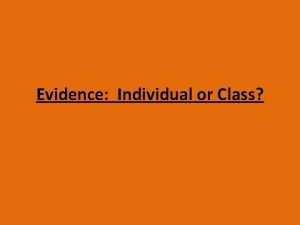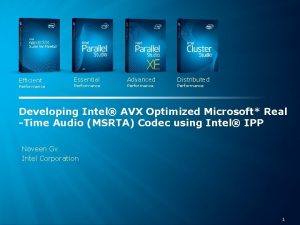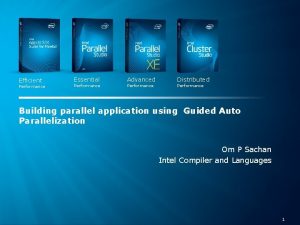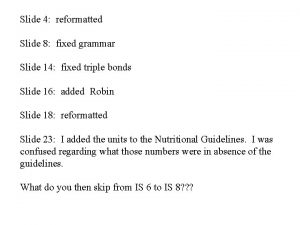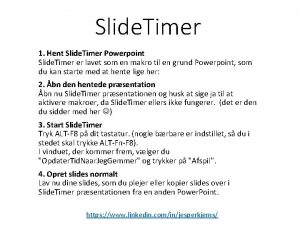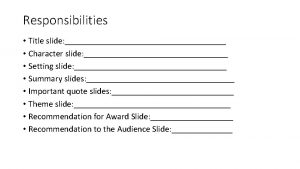Slide 12 1 The Treatment of Individual Performance
































- Slides: 32

Slide 12. 1 The Treatment of Individual Performance • Traditionally centred on the assessment of performance and the allocation of reward • Typically viewed as the result of the interaction between individual ability and motivation • Planning and enabling performance have a critical effect on individual performance Torrington, Hall & Taylor, Human Resource Management 6 e, © Pearson Education Limited 2005

Slide 12. 2 Appraisal systems • • • Traditionally provided a formalised process to review employee performance Typically designed on a central basis, usually by HR function Typically requires line managers to appraise performance of their staff Appraisal forms often not living forms but archived in HR areas Issues of performance are often neglected until next appraisal Torrington, Hall & Taylor, Human Resource Management 6 e, © Pearson Education Limited 2005

Slide 12. 3 What is Appraised • Varies between organisations • Can cover – personality, behaviour or job performance Torrington, Hall & Taylor, Human Resource Management 6 e, © Pearson Education Limited 2005

Slide 12. 4 Qualitative Appraisal • Can involve writing an unstructured narrative on the general performance of the appraisee • Guidance may be provided on areas to assess • Can leave important areas unappraised Torrington, Hall & Taylor, Human Resource Management 6 e, © Pearson Education Limited 2005

Slide 12. 5 What is actually measured • Extent the individual conforms to the organisation (Coates, 1994) • Some traditional appraisal - personality traits • Behaviour and performance on the job • Aspects of the job or major headings on the job description • Measure job objectives Torrington, Hall & Taylor, Human Resource Management 6 e, © Pearson Education Limited 2005

Slide 12. 6 Linking Ratings to Behaviour • Behaviour anchored rating scales - BARS • Behavioural Observations Scales - BOS Torrington, Hall & Taylor, Human Resource Management 6 e, © Pearson Education Limited 2005

Slide 12. 7 Electronic Surveillance Systems • Activity rates of computer operators can be recorded analysed • How calls of telephone staff can be analysed Torrington, Hall & Taylor, Human Resource Management 6 e, © Pearson Education Limited 2005

Slide 12. 8 Mystery Shoppers Testing the performance of sales staff by sending in assessors acting as customers Torrington, Hall & Taylor, Human Resource Management 6 e, © Pearson Education Limited 2005

Slide 12. 9 Level of Appraisal IRS Survey, 2003: 79 of 96 very large employers appraised employees Torrington, Hall & Taylor, Human Resource Management 6 e, © Pearson Education Limited 2005

Slide 12. 10 Concerns over Appraisal • • • Treated as an administrative exercise Ineffective Does little to improve performance of employees in the future Lack clarity of purpose Expected to deliver in too many areas Used for both development and pay which conflict Torrington, Hall & Taylor, Human Resource Management 6 e, © Pearson Education Limited 2005

Slide 12. 11 Common Reasons for Failure – American Research • • Unclear performance criteria Ineffective rating instrument Poor working relationship with the boss Appraiser lacked information on the manager’s actual performance (Longenecker, 1997) Torrington, Hall & Taylor, Human Resource Management 6 e, © Pearson Education Limited 2005

Slide 12. 12 Other Problems Indicated • • Lack of ongoing performance feedback Lack of focus on management development / improvement Problems with the process Review process lacking substance Torrington, Hall & Taylor, Human Resource Management 6 e, © Pearson Education Limited 2005

Slide 12. 13 Who Owns the System? • Designed and imposed by HR – little ownership by line managers • If forms completed and returned to HR – may be seen as paper filling exercise by the line Torrington, Hall & Taylor, Human Resource Management 6 e, © Pearson Education Limited 2005

Slide 12. 14 Performance Management Systems • Increasingly seen as a way to manage employee performance • Incorporates appraisal/review process • A framework where performance can be directed, monitored, and links in the cycle audited (Mabey & Salaman, 1995) Torrington, Hall & Taylor, Human Resource Management 6 e, © Pearson Education Limited 2005

Slide 12. 15 Advantages of Performance Management Systems • Being tied closely into the objectives of the organisation • Represent a more holistic view of performance • Appraisal or review is integrated with performance planning • Performance is assessed and successful performance rewarded and reinforced (Bevan & Thompson, 1992) Torrington, Hall & Taylor, Human Resource Management 6 e, © Pearson Education Limited 2005

Slide 12. 16 Conceptual Foundation of Performance Management • Relies on view that performance is more than ability and motivation • Clarity of goals is key • Goals are seen as motivators – Goal theory Torrington, Hall & Taylor, Human Resource Management 6 e, © Pearson Education Limited 2005

Slide 12. 17 Expectancy Theory & Performance Management • Individuals motivated to act provided they expect to achieve the goals set • Belief that achieving goals will lead to rewards • Belief that rewards on offer are valued Torrington, Hall & Taylor, Human Resource Management 6 e, © Pearson Education Limited 2005

Slide 12. 18 Development Driven or Reward Driven 85% companies surveyed – linked performance management to pay Armstrong and Baron – found that only 43% of organisations reported such a link 82% had performance related pay IPD Survey 1992 Torrington, Hall & Taylor, Human Resource Management 6 e, © Pearson Education Limited 2005

Slide 12. 19 Differences Between Performance Management & MBO An off the peg system Performance management Tends to be tailor made Generally involves objectives being imposed on managers from above Produced in house Emphasis on mutual objective setting & ongoing support Torrington, Hall & Taylor, Human Resource Management 6 e, © Pearson Education Limited 2005

Slide 12. 20 Characteristics of Performance Management Systems Table 12. 1 Characteristics of performance management systems Torrington, Hall & Taylor, Human Resource Management 6 e, © Pearson Education Limited 2005

Slide 12. 21 Stages of a Typical Performance Management System Figure 12. 1 Stages of a typical performance management system Torrington, Hall & Taylor, Human Resource Management 6 e, © Pearson Education Limited 2005

Slide 12. 22 An Objective Setting Cascade Figure 12. 2 An objective-setting cascade Torrington, Hall & Taylor, Human Resource Management 6 e, © Pearson Education Limited 2005

Slide 12. 23 A Shared View of Expected Performance • • • Individual objectives derived from team objectives An agreed job description jointly devised Objectives are outcome or results oriented Objectives are tightly defined and include measures to be assessed Objectives designed to stretch individuals and offer potential for development Torrington, Hall & Taylor, Human Resource Management 6 e, © Pearson Education Limited 2005

Slide 12. 24 SMART Objectives • • • Specific Measurable Appropriate Relevant Timed Torrington, Hall & Taylor, Human Resource Management 6 e, © Pearson Education Limited 2005

Slide 12. 25 Delivering & Monitoring Performance The manager’s role – • Enabling role while staff are working to achieve the performance agreed • Organising resources • Organising off-job training • Being accessible • Providing ongoing coaching • Providing support & guidance Torrington, Hall & Taylor, Human Resource Management 6 e, © Pearson Education Limited 2005

Slide 12. 26 Reviews Normally informal Need not be part of formal system Can take place as needed Provide a forum for employee reward in terms of recognition of progress Torrington, Hall & Taylor, Human Resource Management 6 e, © Pearson Education Limited 2005

Slide 12. 27 Formal Performance Review & Assessment Need to concentrate on development issues to motivate Extent objectives have been met Torrington, Hall & Taylor, Human Resource Management 6 e, © Pearson Education Limited 2005

Slide 12. 28 Reward • Some systems still include link to money • Promotion and development often used as a reward Torrington, Hall & Taylor, Human Resource Management 6 e, © Pearson Education Limited 2005

Slide 12. 29 Critique (1 of 2) • • Needs to be line driven not HR driven Training in the introduction and use of system required System is only as good as the people who operationalise it Integration of activities important Torrington, Hall & Taylor, Human Resource Management 6 e, © Pearson Education Limited 2005

Slide 12. 30 Critique (2 of 2) • • Can suffer from same problems as traditional appraisal systems Managers can be influenced by subjective feelings Performance ratings can be de-motivating SMART targets can cause problems if not reviewed and updated regularly Torrington, Hall & Taylor, Human Resource Management 6 e, © Pearson Education Limited 2005

Slide 12. 31 360 Degree Feedback Whole range of feedback sought from a range of people and sources, e. g. : Peers Subordinates More senior managers Internal customers External customers Individuals themselves Torrington, Hall & Taylor, Human Resource Management 6 e, © Pearson Education Limited 2005

Slide 12. 32 Summary • • Performance management systems include more than appraisals There is conflict in many appraisal and performance management systems Current trends include greater employee ownership and involvement 360 degree feedback is becoming more widely used Torrington, Hall & Taylor, Human Resource Management 6 e, © Pearson Education Limited 2005
 Heel toe polka music
Heel toe polka music Performance management team csc
Performance management team csc Slide divide factoring
Slide divide factoring Hình ảnh bộ gõ cơ thể búng tay
Hình ảnh bộ gõ cơ thể búng tay Slidetodoc
Slidetodoc Bổ thể
Bổ thể Tỉ lệ cơ thể trẻ em
Tỉ lệ cơ thể trẻ em Voi kéo gỗ như thế nào
Voi kéo gỗ như thế nào Thang điểm glasgow
Thang điểm glasgow Hát lên người ơi
Hát lên người ơi Các môn thể thao bắt đầu bằng tiếng nhảy
Các môn thể thao bắt đầu bằng tiếng nhảy Thế nào là hệ số cao nhất
Thế nào là hệ số cao nhất Các châu lục và đại dương trên thế giới
Các châu lục và đại dương trên thế giới Công thức tính độ biến thiên đông lượng
Công thức tính độ biến thiên đông lượng Trời xanh đây là của chúng ta thể thơ
Trời xanh đây là của chúng ta thể thơ Cách giải mật thư tọa độ
Cách giải mật thư tọa độ 101012 bằng
101012 bằng Phản ứng thế ankan
Phản ứng thế ankan Các châu lục và đại dương trên thế giới
Các châu lục và đại dương trên thế giới Thơ thất ngôn tứ tuyệt đường luật
Thơ thất ngôn tứ tuyệt đường luật Quá trình desamine hóa có thể tạo ra
Quá trình desamine hóa có thể tạo ra Một số thể thơ truyền thống
Một số thể thơ truyền thống Cái miệng bé xinh thế chỉ nói điều hay thôi
Cái miệng bé xinh thế chỉ nói điều hay thôi Vẽ hình chiếu vuông góc của vật thể sau
Vẽ hình chiếu vuông góc của vật thể sau Nguyên nhân của sự mỏi cơ sinh 8
Nguyên nhân của sự mỏi cơ sinh 8 đặc điểm cơ thể của người tối cổ
đặc điểm cơ thể của người tối cổ Giọng cùng tên là
Giọng cùng tên là Vẽ hình chiếu đứng bằng cạnh của vật thể
Vẽ hình chiếu đứng bằng cạnh của vật thể Fecboak
Fecboak Thẻ vin
Thẻ vin đại từ thay thế
đại từ thay thế điện thế nghỉ
điện thế nghỉ Tư thế ngồi viết
Tư thế ngồi viết

